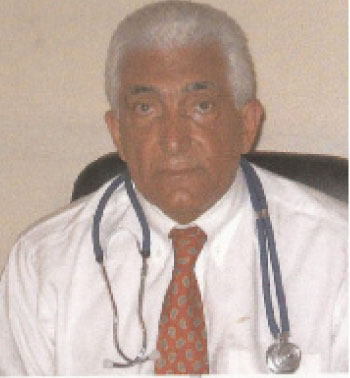
Sickle-cell disorder killing 100,000 infants a year in
Estimates suggest that 50–80% of children with undiagnosed sickle cell anaemia will die before adulthood.
At least 100,000 infants die from the sickle-cell genetic disorder in
Based on World Health Organization (WHO) indices,
According to the WHO, 200,000 infants are born with sickle-cell in Africa every year, sickle-cell disease is an incurable genetic disorder widespread in sub-Saharan
Sufferers have no visible symptoms, but periodically experience severe pain and are also highly prone to anaemia because the blood cells break down after only 10-20 days, rather than the usual four months.
Dr Hassan Azadeh, our health adviser, a senior lecturer at the UTG and senior consultant in Obstetrics and Gynaecology in support of “SICKLE CELL ASSOCIATION OF THE GAMBIA” explains about this deadly and incurable African inheritable genetical disease in the Gambia and focuses on causes, signs, symptoms, the way of diagnose and the treatment facilities in The Gambia.
The Point: What is actually sickle cell disease?
Dr Azadeh: Sickle Cell Disease is a hereditary disorder that affects people in ways that can be felt and seen, such as causing pain and swelling. It also affect people in less obvious ways such as slowing physical development, damage to internal organs such as liver, kidneys, and spleen. It causes stroke, eye sight problems, acute chest syndrome, pianism, blindness and premature death among many more. The Sickle Cell is not contagious unlike cold or HIV, you have to be born with it.
A person can only inherit sickle-cell disorder if both parents are carriers of the genetic trait, and then there is a one in four chance of giving birth to an affected child. WHO says that in some parts of sub-Saharan
Links with malaria?
According to the WHO, sickle-cell is particularly prevalent in areas of high malarial transmission.
The mutant sickle-cell gene confers a survival advantage against malaria which explains the prevalence of the disease where malaria is endemic.
Carriers of sickle-cell are less prone to being infected with malaria, which attacks red blood cells. However, those with sickle-cell disease are more vulnerable to malaria because of their weakened health, experts say.
Although sickle-cell in infants is curable through bone marrow transplants, lack of expertise and the high cost of the operation make preventive measures the best option, medical experts say.
“This is why we advocate genetic counselling by intending couples before marriage to determine the status of their genes.
People should go for a genetic test in the same way they determine their HIV status before marriage as the most effective way to protect their children and curtail the disease.
Sickle-cell contributes to 9 percent of deaths in children under five in
The greatest burden of sickle cell anaemia (SCA) is in sub-Saharan Africa (SSA), where 75% of the 300,000 global births of affected children live. The World Health Organization estimate that 70% of SCA deaths in Africa are preventable with simple, cost-effective interventions such as early identification of SCA patients by newborn screening (NBS) and the subsequent provision of comprehensive care.
Identification of risk factors has led to improved survival through targeted interventions. In the West, reported risk factors for death include infections, low blood level and high white blood cell count. Comprehensive care includes prompt treatment of acute events against infections, mainly with oral penicillin and vaccination against pneumonia (lung infection).
Countries that have introduced these interventions have achieved significant reductions in mortality (death); with up to 94% surviving to 18 years. In most African countries, the lack of an evidence-base has led to inertia in terms of implementation of these interventions, such as penicillin treatment.
One of the first steps in addressing this lack of knowledge is to provide an estimate of mortality rates to highlight the burden of disease due to SCA. The ideal approach is to establish a cohort of SCA patients, diagnosed at birth, and follow them up to determine rate and cause of death. Information from such cohorts is biased, as it will on one hand consist of healthy survivors and on the other, will not identify those with mild disease who do not seek healthcare or those with severe disease who have died.
Sickle cell disease is a group of disorders that affects blood factor haemoglobin, the molecule in red blood cells that delivers oxygen to cells throughout the body. People with this disorder have atypical haemoglobin molecules called haemoglobin S, which can distort red blood cells into a sickle, or crescent, shape.
Signs and symptoms of sickle cell disease usually begin in early childhood. Characteristic features of this disorder include a low number of red blood cells (anaemia), repeated infections, and periodic episodes of pain. The severity of symptoms varies from person to person. Some people have mild symptoms, while others are frequently hospitalized for more serious complications.
The signs and symptoms of sickle cell disease are caused by the sickling of red blood cells. When red blood cells sickle, they break down prematurely, which can lead to anaemia. Anaemia can cause shortness of breath, fatigue, and delayed growth and development in children. The rapid breakdown of red blood cells may also cause yellowing of the eyes and skin, which are signs of jaundice.
Painful episodes can occur when sickled red blood cells, which are stiff and inflexible, get stuck in small blood vessels. These episodes deprive tissues and organs of oxygen-rich blood and can lead to organ damage, especially in the lungs, kidneys, spleen, and brain.
A particularly serious complication of sickle cell disease is high blood pressure in the blood vessels that supply the lungs (pulmonary hypertension). Pulmonary hypertension occurs in about one-third of adults with sickle cell disease and can lead to heart failure.
How common is sickle cell disease?
Sickle cell disease affects millions of people worldwide. It is most common among people whose ancestors come from Africa; Mediterranean countries such as
Sickle cell disease is the most common inherited blood disorder in the
How do people inherit sickle cell disease?
This condition is inherited in a recessive pattern, which means both copies of the gene in each cell have mutations. The parents of an individual with a recessive condition each carry one copy of the mutated gene, but they typically do not show signs and symptoms of the condition.
Management (treatment)
Folic acid and penicillin
Children born with sickle-cell disease will undergo close observation by the paediatrician and will require management by a haematologist (blood specialist) to assure they remain healthy. These patients will take a 1 mg dose of folic daily for life. From birth to five years of age, they will also have to take penicillin daily due to the immature immune system that makes them more prone to early childhood illnesses.
Malaria prevention
The protective effect of sickle cell trait does not apply to people with sickle cell disease; in fact, they are uniquely vulnerable to malaria, since the most common cause of painful crises in malarial countries is infection with malaria. It has therefore been recommended that people with sickle cell disease living in malarial countries should receive anti-malarial tablets for life
Sickle cell crisis
Most people with sickle-cell disease have intensely painful episodes called crises. The frequency, severity, and duration of these crises, however, vary tremendously. Painful crises are treated symptomatically with pain management requires at regular intervals until the crisis has settled..
Acute chest crisis
Management is similar to above crisis, with the addition of antibiotics, bacteria are thought to contribute to the syndrome), oxygen supplementation, and close observation. Should the lung infiltrate worsen or the oxygen requirements increase, simple blood transfusion is indicated.
Blood Transfusion therapy, Blood transfusions are often used in the management of sickle cell disease in acute cases and to prevent complications by decreasing the number of red blood cells (RBC) that can sickle by adding normal red blood cells.
Advice from the
Prevention through Genotype Testing
Genotype testing is a painless procedure that let you know a little bit more about your haemoglobin genes which could be normal (AA), Stickled (SS) or a trait (AS).
Things to do - Healthy living tips
• Get regular checkups from knowledgeable heath care providers.
• Your blood count, urine and eyes should be checked during examination.
• Infant must take penicillin daily from 2 months till 6 years to prevent serious infections
• Children must receive all scheduled immunizations
• Get booster immunizations
• Take the vitamins specially folic acid daily to help make new red blood cells
• A special diet is not necessary, however green leafy veggies are highly recommended
• Drink plenty of water (8-10 glasses a day)
• Get plenty of rest
• Avoid over exertion and stress
• Avoid extreme cold and heat
Things you must avoid
• No smoking and avoid smoke filled rooms
• Avoid alcohol intake
• Avoid junk fopods, they give you instant satisfaction, but are poor in nutritional value
• Avoid excessive dry skin
• Avoid unhealthy sexual lifestyles, promiscuous and multiple behaviour and multiple sexual partners.
• Avoid the use of drugs
You can get more information about this common disease in the Gambia from “THE GAMBIA SICKLE CELL ASSOCIATION” Mr Andrew Sambou Ministry of Education Tel. 3651010, 6581433, 9988814, 9955887, or E Mail Sicklecellassngambia@gmail.com or visit any Governments, NGO’s and private Hospitals and clinics throughout the country or mail azadehhassan@yahoo.co.uk or call Dr Azadeh’s live health show on” AFRI RADIO 1076” every Wed. From 9-9.30 am text on 7774469 during the week between 3-6pm.


